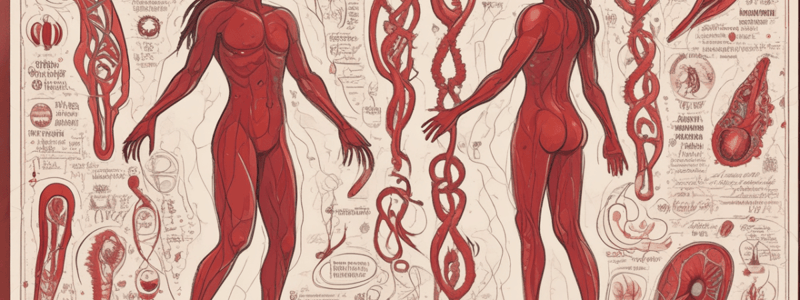Podcast
Questions and Answers
What is the primary function of hemoglobin in red blood cells?
What is the primary function of hemoglobin in red blood cells?
- To produce energy for the body
- To carry carbon dioxide to the lungs
- To regulate body temperature
- To carry oxygen to the body's tissues (correct)
What is the pattern of inheritance for sickle cell anemia?
What is the pattern of inheritance for sickle cell anemia?
- Mitochondrial inheritance
- X-linked recessive
- Autosomal dominant
- Autosomal recessive (correct)
What is the name of the abnormal hemoglobin produced in sickle cell anemia?
What is the name of the abnormal hemoglobin produced in sickle cell anemia?
- Hemoglobin S (correct)
- Hemoglobin A
- Hemoglobin C
- Hemoglobin B
What is a common symptom of sickle cell anemia?
What is a common symptom of sickle cell anemia?
Why do red blood cells become misshapen in sickle cell anemia?
Why do red blood cells become misshapen in sickle cell anemia?
What is the purpose of genetic testing in sickle cell anemia?
What is the purpose of genetic testing in sickle cell anemia?
What is the usual age range for diagnosis of sickle cell anemia?
What is the usual age range for diagnosis of sickle cell anemia?
What is the primary goal of treatment for sickle cell anemia?
What is the primary goal of treatment for sickle cell anemia?
What is a potential treatment option for sickle cell anemia?
What is a potential treatment option for sickle cell anemia?
Why are blood transfusions sometimes necessary in sickle cell anemia?
Why are blood transfusions sometimes necessary in sickle cell anemia?
Flashcards are hidden until you start studying
Study Notes
Definition and Causes
- Sickle cell anemia is a genetic disorder that affects the production of hemoglobin, a protein in red blood cells that carries oxygen to the body's tissues.
- It is caused by a mutation in the HBB gene that codes for hemoglobin, leading to the production of abnormal hemoglobin called sickle hemoglobin (HbS).
- The mutation is inherited in an autosomal recessive pattern, meaning that a person must inherit two copies of the mutated gene (one from each parent) to develop the condition.
Symptoms
- The symptoms of sickle cell anemia can vary in severity, but may include:
- Anemia (low red blood cell count)
- Fatigue
- Shortness of breath
- Dizziness
- Pale skin
- Yellowing of the skin and eyes (jaundice)
- Pain episodes (crises)
- Increased risk of infections
- Delayed growth and development
Pathophysiology
- The abnormal hemoglobin in sickle cell anemia causes red blood cells to become misshapen and rigid, taking on a sickle shape.
- These sickle-shaped cells can get stuck in small blood vessels, blocking blood flow and causing tissue damage.
- The abnormal cells are also more prone to rupture, leading to anemia and other complications.
Diagnosis
- Sickle cell anemia can be diagnosed with a blood test that detects the presence of HbS.
- The test is usually performed on newborns, but can also be done on people of any age.
- Genetic testing can also be used to identify carriers of the mutation.
Treatment and Management
- Treatment for sickle cell anemia typically focuses on managing symptoms and preventing complications.
- Medications may be used to:
- Reduce pain and inflammation
- Increase red blood cell production
- Prevent infections
- Manage other related conditions
- Blood transfusions may be necessary in some cases.
- Bone marrow transplantation can be a curative treatment option for some people.
- Lifestyle modifications, such as staying hydrated and avoiding extreme temperatures, can also help manage the condition.
Complications
- Sickle cell anemia can lead to a range of complications, including:
- Increased risk of infections
- Organ damage (e.g. kidney, liver, spleen)
- Stroke
- Blindness
- Pulmonary hypertension
- Priapism (painful erection)
- Leg ulcers
- Increased risk of death
Definition and Causes
- Sickle cell anemia is a genetic disorder affecting hemoglobin production in red blood cells.
- It is caused by a mutation in the HBB gene, leading to the production of abnormal hemoglobin called sickle hemoglobin (HbS).
- The mutation is inherited in an autosomal recessive pattern, requiring two copies of the mutated gene to develop the condition.
Symptoms
- Anemia (low red blood cell count) can lead to fatigue, shortness of breath, and dizziness.
- Pale skin and yellowing of the skin and eyes (jaundice) are common symptoms.
- Pain episodes (crises) can occur, increasing the risk of infections.
- Delayed growth and development are possible complications.
Pathophysiology
- Abnormal hemoglobin causes red blood cells to become misshapen and rigid, taking on a sickle shape.
- Sickle-shaped cells can get stuck in small blood vessels, blocking blood flow and causing tissue damage.
- Abnormal cells are more prone to rupture, leading to anemia and other complications.
Diagnosis
- Sickle cell anemia can be diagnosed with a blood test detecting the presence of HbS.
- The test is usually performed on newborns but can be done on people of any age.
- Genetic testing can identify carriers of the mutation.
Treatment and Management
- Medications can reduce pain and inflammation, increase red blood cell production, and prevent infections.
- Blood transfusions may be necessary in some cases.
- Bone marrow transplantation can be a curative treatment option for some people.
- Lifestyle modifications, such as staying hydrated and avoiding extreme temperatures, can help manage the condition.
Complications
- Increased risk of infections is a common complication.
- Organ damage can occur, affecting the kidney, liver, and spleen.
- Stroke, blindness, and pulmonary hypertension are potential complications.
- Priapism (painful erection), leg ulcers, and increased risk of death are also possible.
Studying That Suits You
Use AI to generate personalized quizzes and flashcards to suit your learning preferences.



